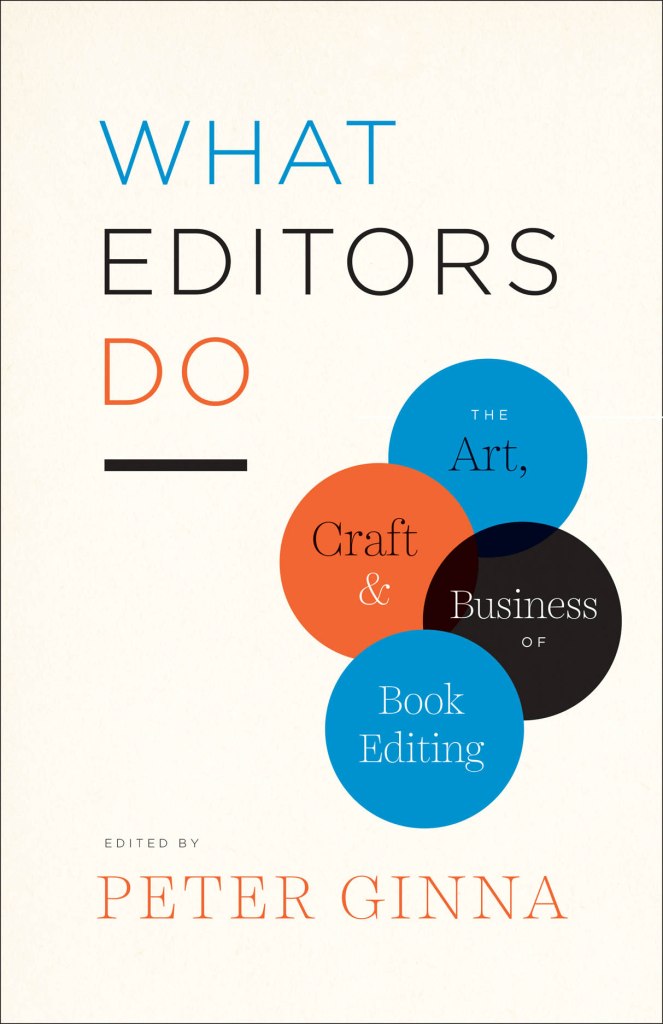by Mahima Bhagwat
Targeted toward those in the traditional book editing space, What Editors Do is a collection of personal experiences and advice from accomplished editors who each talk about an aspect of editing that they specialize in. With discussions of case studies, true descriptions of the nitty-gritty of being an editor, and passionate encouragement for actively participating in the traditional book publishing industry, this essay collection is a helpful and insightful read for any modern book editor—new or experienced, in-house or freelance.
What Editors Do is helpfully organized into five parts. The first three cover the process of acquisition and the editor’s role in the various steps a publishing house goes through to bring a book to market. The fourth discusses editing different genres. The fifth provides helpful suggestions for the paths one can take to establish an editing career, as well as what the future of book editing might look like. Readers will find that they can hop between chapters and access the information they want as non-linearly as desired without losing any context. For example, those wanting fantasy editing tips can consult chapter 15, “Dukes, Deaths, and Dragons: Editing Genre Fiction” by Diana Gill; someone wanting to understand how to handle a sensitive author should check out “What Love’s Got to Do with It: The Author-Editor Relationship,” by editor turned literary agent Betsy Lerner.
Despite the variations in subjects across the chapters and parts, the throughline in What Editors Do is the editor’s love for finding a compelling story and a unique voice, one that is both a pleasure and honour to enhance and promote. The book acknowledges that, for an editor, the process of editing a book is often both highly technical and highly intimate. It’s not just about suggesting better ways to say things. Editorial labour, especially as an in-house editor, is also about championing your author, understanding the market, and guiding the author through the minutiae of the process of making their writing available to readers. The essay contributors all touch on the importance of being the connection point between the author and the reader—and this, truly, is the boiled-down version of the wide range of possible responses to the question “What do editors do?” If there is one message to take away from this text, it is that an editor’s job is to represent the reader’s interest to the author. Though there are a myriad of methods to do so, ultimately, enhancing the voice of the author to effectively reach as large a reading audience as possible is the purpose of engaging in the art, craft, and business of editing.
In the introduction, Ginna explains that book editing is an art, requiring taste and aesthetic sensibilities, a craft, requiring technical skill and expertise, and a business, requiring an understanding of the commercial processes involved in distributing a text to the public. As such, What Editors Do covers these three aspects through the experiences of those who have been working in the industry for decades and who have seen it go through continuous changes—from the rampant merging of publishing houses to the onslaught of self-published ebooks. Someone relatively new to the business of book publishing will find the recounting of these changes in the industry from such different perspectives highly edifying. It’s no surprise, then, that this book makes a perfect textbook for an editing course. (It was assigned as reading for the Simon Fraser University Master of Publishing editing course for the cohort I was part of.) It’s a useful learning resource for student editors, since book editors work in an industry where most of the learning, especially about the art and business of editing, happens on the job rather than through a dedicated curriculum. Additionally, publishing colleagues, book coaches, writers, and literary agents will also find the text enlightening.
Of course, What Editors Do does not cover every aspect of book editing as a career. Its wide range of topics does not delve into technical editing, or plain language tips and tricks, or the mechanics of proofing a typesetter’s page layout—but it isn’t meant to. Book editors have a wide range of jobs and duties in the ever-evolving, technologically driven publishing landscape and one book cannot cover all this without quickly becoming outdated. What the book does do, in an efficient and engaging format, is provide insight into the ethos of book editors, what it is that really gives their work purpose, and how they can grow to fulfill that purpose. For any book editor, What Editors Do is a useful resource with a long (book)shelf-life.
Mahima Bhagwat is the Vancouver-based owner of Angler Editing. She focuses on helping creators enhance their narratives in genres ranging from fantasy to self-help. Her years spent crafting blog articles for SEO and designing e-learning courses for corporate employees built the editing skills she uses today.
This article was copy edited by Anne Marie Twiselton, a freelance editor that resides in the Greater Toronto Area.


I am pleased to be the author of chapter 24 of the book: “This Pencil for Hire: Making a Career as a Freelance Editor.”
https://press.uchicago.edu/ucp/books/book/chicago/W/bo21439635.html#anchor-table-of-contents
LikeLike
Great chapter!
LikeLiked by 1 person